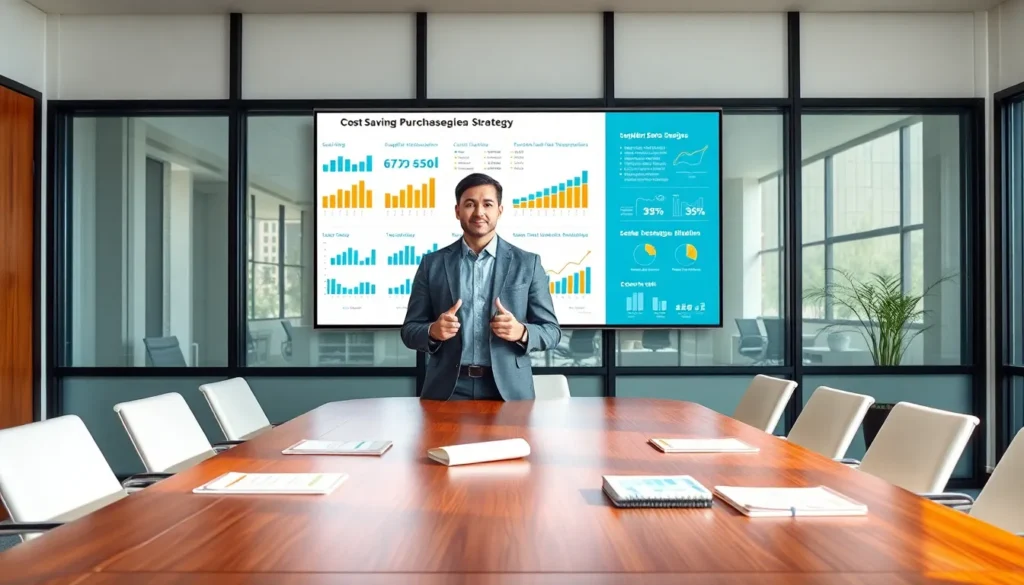Table of Contents
ToggleIn today’s fast-paced market, companies seek every edge to boost profits and efficiency. Purchasing isn’t just about buying, it’s a minefield of potential savings waiting to be uncovered. Imagine trimming costs without skimping on quality. Intrigued? From clever negotiations to savvy technology use, effective purchasing strategies can spell the difference between thriving and just surviving. Let’s jump into the art of spending wisely, where every dollar saved is a step closer to financial victory.
Understanding Cost Saving in Purchasing

Importance of Cost Efficiency
Cost efficiency isn’t merely a trendy buzzword: it’s a business imperative. Companies that focus on reducing purchasing costs often experience improved profit margins and enhanced competitiveness. Recognizing this, leaders are on the lookout for strategies to streamline expenditures, ensuring they get the best bang for their buck without compromising quality.
Factors Influencing Purchasing Costs
A range of factors can dramatically influence purchasing costs. Understanding these factors enables businesses to strategize accordingly. Market demand, supplier pricing, and logistical expenses all contribute to overall costs. Also, fluctuations in currency exchange rates and tariffs can unpredictably shift product prices. Hence, keeping an eye on these elements can provide significant insight into potential savings.
Key Cost Saving Strategies
Bulk Purchasing
One of the most effective cost-saving strategies is bulk purchasing. By buying in larger quantities, companies can often negotiate lower prices per unit. This approach isn’t just about hoarding goods, it’s a calculated move that can lead to substantial long-term savings. Wholesalers and manufacturers often lower their rates for bulk orders, allowing businesses to stock up on essential items at a fraction of the cost.
Supplier Negotiations
Negotiating with suppliers is a critical skill in the purchasing game. Experts suggest that building relationships with suppliers can lead to better deals. When suppliers perceive a partnership, they’re more inclined to offer discounts or favorable terms. Long-standing relationships often yield dividends in the form of loyalty discounts and priority service, maximizing value in every purchase.
Utilizing Technology and Automation
Technology has transformed purchasing processes, ushering in a new era of efficiency. Automated systems can manage everything from generating purchase orders to tracking inventory levels. These systems reduce human error and streamline operations, eventually saving both time and money. For instance, using procurement software can help businesses analyze spending patterns and make informed purchasing decisions.
Evaluating Total Cost of Ownership (TCO)
Considering the Total Cost of Ownership is crucial in identifying true savings. TCO encompasses not just the initial purchase price but also maintenance costs, operational expenses, and disposal fees. By evaluating these factors, businesses can better understand the long-term financial implications of their purchases, enabling smarter decisions that promote not only immediate costs savings but sustained financial health.
Streamlining Procurement Processes
Standardizing Purchase Orders
Standardization in purchase orders can significantly enhance efficiency. By establishing a consistent format, companies can reduce processing times, minimize errors, and streamline approvals. Standardization also aids in mapping out spending patterns, aiding in future negotiations and strategy development.
Implementing Supplier Scorecards
Supplier scorecards help effective monitoring of supplier performance. By evaluating suppliers based on criteria like quality, delivery time, and cost, businesses can identify who delivers the best value. Making data-driven decisions based on these scorecards ensures that companies invest with confidence in their suppliers while promoting a competitive environment.
Monitoring Market Trends
Identifying Price Fluctuations
Regularly monitoring market trends is essential for savvy purchasing. Price fluctuations can impact purchasing decisions significantly: so, being aware of impending changes enables companies to act proactively. For example, timing purchases to coincide with seasonal discounts or town-wide sales can yield immense savings.
Adapting to Market Changes
The ability to adapt to market changes is a valuable asset. Economic downturns, natural disasters, or shifts in consumer behavior can alter prices overnight. Remaining flexible allows businesses to pivot purchasing strategies swiftly, ensuring they remain competitive and cost-effective.




